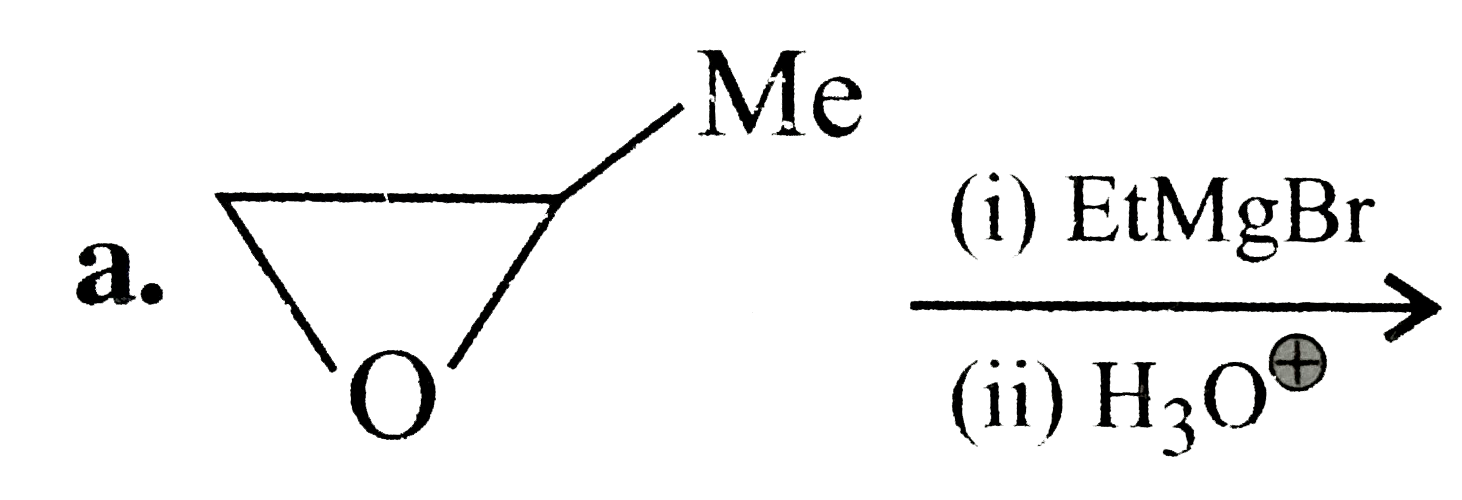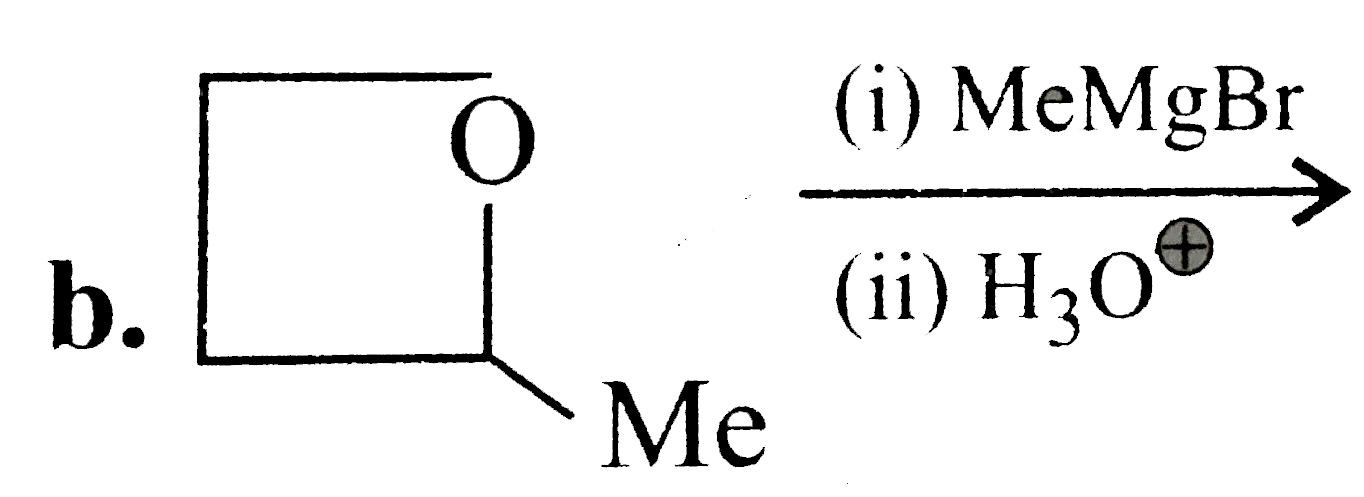Which of the following reactions would give pentan−2−ol ?



MeCHOPrmgBr/ether−−−−−−−−→H3O⊕
The correct Answer is:A, B, C, D
To determine which of the given reactions would yield pentan-2-ol, we need to analyze each option step by step. Pentan-2-ol has the following structure:
CH3|CH3−CH−CH2−CH3|OH
This indicates that the hydroxyl group (-OH) is attached to the second carbon of a five-carbon chain (pentane).
Step 1: Analyze Each Option
Option 1:
- The reaction involves a Grignard reagent (R-MgBr) reacting with a carbonyl compound (ketone or aldehyde).
- If we assume the carbonyl compound is a ketone like butan-2-one (CH3-CO-CH2-CH3), the Grignard reagent (e.g., CH3MgBr) adds to the carbonyl carbon, forming a tertiary alcohol after hydrolysis.
- The final product will be pentan-2-ol.
Option 2:
- Similar to Option 1, if we use a Grignard reagent with a different carbonyl compound, such as propan-2-one (CH3-CO-CH3), and add CH3MgBr, we can also form pentan-2-ol after hydrolysis.
- The reaction will yield pentan-2-ol as well.
Option 3:
- In this case, if we start with a compound like 1-bromopropane (CH3-CH2-CH2-Br) and react it with a Grignard reagent (e.g., CH3MgBr), the product after hydrolysis will also yield pentan-2-ol.
- The mechanism involves the formation of a new carbon-carbon bond, leading to the desired alcohol.
Option 4:
- Here, if we start with a carbonyl compound like butanal (CH3-CH2-CHO) and react it with a Grignard reagent, we can also achieve pentan-2-ol.
- The addition of the Grignard reagent to the carbonyl, followed by hydrolysis, will yield pentan-2-ol.
Conclusion
All four options can lead to the formation of pentan-2-ol through different pathways involving Grignard reagents and appropriate carbonyl compounds.
Final Answer
All options (1, 2, 3, and 4) would give pentan-2-ol.
---
- The reaction involves a Grignard reagent (R-MgBr) reacting with a carbonyl compound (ketone or aldehyde).
- If we assume the carbonyl compound is a ketone like butan-2-one (CH3-CO-CH2-CH3), the Grignard reagent (e.g., CH3MgBr) adds to the carbonyl carbon, forming a tertiary alcohol after hydrolysis.
- The final product will be pentan-2-ol.
- Similar to Option 1, if we use a Grignard reagent with a different carbonyl compound, such as propan-2-one (CH3-CO-CH3), and add CH3MgBr, we can also form pentan-2-ol after hydrolysis.
- The reaction will yield pentan-2-ol as well.
- In this case, if we start with a compound like 1-bromopropane (CH3-CH2-CH2-Br) and react it with a Grignard reagent (e.g., CH3MgBr), the product after hydrolysis will also yield pentan-2-ol.
- The mechanism involves the formation of a new carbon-carbon bond, leading to the desired alcohol.
- Here, if we start with a carbonyl compound like butanal (CH3-CH2-CHO) and react it with a Grignard reagent, we can also achieve pentan-2-ol.
- The addition of the Grignard reagent to the carbonyl, followed by hydrolysis, will yield pentan-2-ol.
All options (1, 2, 3, and 4) would give pentan-2-ol.
Topper's Solved these Questions
- GRIGNARD REAGENTS AND ORGANOMETALLIC REAGENTSBOOK - CENGAGE CHEMISTRY ENGLISHCHAPTER - GRIGNARD REAGENTS AND ORGANOMETALLIC REAGENTSEXERCISE - Exercises (Single Correct)
47 Videos
- GRIGNARD REAGENTS AND ORGANOMETALLIC REAGENTSBOOK - CENGAGE CHEMISTRY ENGLISHCHAPTER - GRIGNARD REAGENTS AND ORGANOMETALLIC REAGENTSEXERCISE - Exercises Archives (Single Correct)
4 Videos
- GRIGNARD REAGENTS AND ORGANOMETALLIC REAGENTSBOOK - CENGAGE CHEMISTRY ENGLISHCHAPTER - GRIGNARD REAGENTS AND ORGANOMETALLIC REAGENTSEXERCISE - Exercises (Linked Comprehension)
33 Videos
- GENERAL PRINCIPLES AND PROCESS OF ISOLATION OF ELEMENTSBOOK - CENGAGE CHEMISTRY ENGLISHCHAPTER - GENERAL PRINCIPLES AND PROCESS OF ISOLATION OF ELEMENTSEXERCISE - Archives (Subjective)
14 Videos
- NCERT BASED EXERCISEBOOK - CENGAGE CHEMISTRY ENGLISHCHAPTER - NCERT BASED EXERCISEEXERCISE - Nuclear Chemistry (NCERT Exercise)
29 Videos
Similar Questions
Knowledge Check
Which of the following reactions would give identical product?
A BCH3−O∣∣C−HCH3MgBr−−−−−−−−→⊕H/H2OPCC−−→CCH3−CH3∣C=CH−CH3OsO4−−→HIO4−−→DCH3−CH−CH3alc.KOH−−−−−→O3−−−−−−→Zn−H2O
BCH3−O∣∣C−HCH3MgBr−−−−−−−−→⊕H/H2OPCC−−→CCH3−CH3∣C=CH−CH3OsO4−−→HIO4−−→DCH3−CH−CH3alc.KOH−−−−−→O3−−−−−−→Zn−H2OWhich of the following reactions will give alkyne?
A B
B CH3C−Br∣C∣Br−Br∣C∣Br−CH3Zn,Δ−−−→DH3C−C≡CHHg+2,H2SO4−−−−−−−−→
CH3C−Br∣C∣Br−Br∣C∣Br−CH3Zn,Δ−−−→DH3C−C≡CHHg+2,H2SO4−−−−−−−−→Which of the following reactions would give the best yield of t-butyl methyl ether?
A(CH3)3C−OHH2SO4−−−→140∘CB(CH3)3C−Br+CH3OH→C(CH_(3))_(3)C-Br+CH_(3)overset(ө)(O)Na^(o+)toD(CH3)3C−өO⊕K+CH3Br→
Which of the following reactions would give caproic acid ?
View SolutionWhich of the following reactions would give racemised and retention products ?
View SolutionWhich of the following reactions would give a good yield of hydrocarbon product ?
View SolutionWhich of the following reaction will not give methane?
View SolutionWhich of the following reactions will not give propane ?
View Solution
